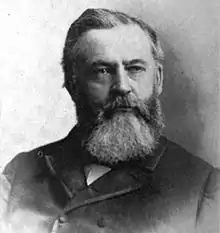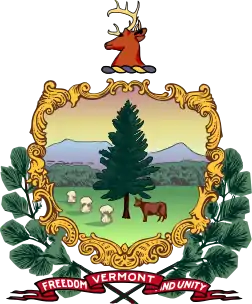Russell S. Taft | |
|---|---|
 | |
| Chief Justice of the Vermont Supreme Court | |
| In office January 12, 1899 – March 22, 1902 | |
| Preceded by | Jonathan Ross |
| Succeeded by | John W. Rowell |
| Associate Justice of the Vermont Supreme Court | |
| In office December 17, 1880 – January 11, 1899 | |
| Preceded by | James Barrett |
| Succeeded by | John H. Watson |
| Member of the Vermont House of Representatives from Burlington | |
| In office October 6, 1880 – December 16, 1880 | |
| Preceded by | Bradley B. Smalley |
| Succeeded by | Robert Roberts |
| Lieutenant Governor of Vermont | |
| In office October 3, 1872 – October 8, 1874 | |
| Governor | Julius Converse |
| Preceded by | George N. Dale |
| Succeeded by | Lyman G. Hinckley |
| Member of the Vermont Senate from Chittenden County | |
| In office October 12, 1865 – October 10, 1867 | |
| Preceded by | Leverett B. Englesby, Amos Hobart, Anson J. Crane |
| Succeeded by | John L. Barstow, Edgar H. Lane, Eleazer R. Hard |
| Register of Probate for Vermont's Chittenden District | |
| In office 1866–1878 | |
| Preceded by | W. S. Burnap |
| Succeeded by | Elihu B. Taft |
| State's Attorney of Chittenden County, Vermont | |
| In office 1862–1865 | |
| Preceded by | Jeremiah French |
| Succeeded by | Leverett B. Englesby |
| Personal details | |
| Born | January 28, 1835 Williston, Vermont |
| Died | March 22, 1902 (aged 67) Burlington, Vermont |
| Resting place | Morse Cemetery, Williston, Vermont |
| Political party | Republican |
| Spouse(s) | Melinda L. Carlisle (m. 1858-1873, her death) Jane Marlett Wyatt (m. 1876-1902, his death) |
| Children | 1 |
| Education | Williston Academy, Williston, Vermont Newbury Academy, Newbury, Vermont |
| Profession | Attorney |
Russell Smith Taft (January 28, 1835 – March 22, 1902) was a lawyer, politician and judge who served as the 29th lieutenant governor of Vermont and chief justice of the Vermont Supreme Court.
Early life
Russell Smith Taft was born in Williston, Vermont, on January 28, 1835, the seventh of the children born to Elijah and Orinda (Kimball) Taft.[1] He attended schools in Williston and Burlington, and completed his schooling at Williston Academy in Williston and Newbury Academy in Newbury.[2] He taught school in Wiillston and Richmond, then studied law with George F. Edmunds, Torrey E. Wales and others, and attained admission to the bar in 1856.[3][4]
After passing the bar, Taft practiced in Burlington in partnership with Wales for 21 years.[3] Among the prospective attorneys who learned the law in the Wales and Taft office was Rufus E. Brown, who later served as Vermont Attorney General.[5] Taft was also the first president of the Vermont Life Insurance Company, and later served as its vice president.[6][7][8]
Civic and professional memberships
Taft was an author on legal and historical topics, and his articles were carried in The Green Bag and other publications.[9] One of his works, an essay on English common law, resulted in membership in London's Selden Society.[9]
In February 1864, Taft became a member of the Royal Arch Masonry chapter in Burlington.[10] In April 1864, he joined the Knights Templar Masonic organization.[10] As a member of the Scottish Rite, he attained the 32nd degree and served as commander in chief of the Vermont consistory.[10]
Political career
A Republican, Taft served as a selectman for the Town of Burlington from 1861 to 1864. After Burlington was incorporated as a city, Taft served as an alderman from 1865 to 1869.[11]
From 1862 to 1865 Taft was Chittenden County State's Attorney, and he was Chittenden County's Register of Probate from 1863 to 1880.[12]
Taft served in the Vermont Senate from 1865 to 1867, and he was Burlington's City Attorney from 1871 to 1872.[13][14]
In 1872 Taft was the successful Republican nominee for lieutenant governor, and he served from October 1872 to October 1874.[15][16] In 1874 he was an unsuccessful candidate for the Republican nomination for governor, losing to Asahel Peck.[17]
Taft represented Burlington in the Vermont House of Representatives in 1880.[18][19][20]
Judicial career
In 1880 the Vermont Assembly elected Taft an associate justice of the Vermont Supreme Court.[2] He served until 1899, when he was appointed chief justice, replacing Jonathan Ross, who had been appointed to the United States Senate.[21][22] He was succeeded as an associate justice by John H. Watson.[23]
Death and burial
Taft served as chief justice until his death, and was succeeded by John W. Rowell. He died in Burlington, Vermont, on March 22, 1902.[24][25][26] He was buried in Williston's Morse Cemetery.[27]
Awards
Chief Justice Taft was the recipient of two honorary degrees from the University of Vermont.[28] In 1877, he received an honorary Master of Arts.[28] He received an honorary Doctor of Laws in 1899.[28]
Family
In 1858, Taft married Melinda L. Carlisle of Malone, New York.[3] She died in 1873, and they had no children.[3] In 1876, Taft married Jane (Marlett) Wyatt, a Burlington teacher who served as principal of the city's grammar school.[21] With his second wife, Taft was the father of Russell Wales Taft (1878-1912), who practiced law in Burlington.[3]
References
- ↑ Stafford, Wendell P. (January 1903). "Russell Smith Taft, LL.D." The New England Historical and Genealogical Register. Boston, MA: New England Historical and Genealogical Society. pp. 11–12 – via Google Books.
- 1 2 "The New Judge". Montpelier Journal. Montpelier, VT. December 4, 1880. p. 2 – via Newspapers.com.
- 1 2 3 4 5 Stafford, p. 12.
- ↑ Rowell, John W. (1902). "Memorial Paper on Russell Smith Taft". Vermont Bar Association Officers, Proceedings, Papers and Addresses. Montpelier, VT: Argus and Patriot Printing House. p. 48 – via Google Books.
- ↑ Carleton, Hiram (1903). Genealogical and Family History of the State of Vermont. Vol. I. New York, NY: Lewis Publishing Company. p. 613 – via Google Books.
- ↑ Biography, Russell S. Taft, The Vermonter magazine, February, 1899, page 112
- ↑ Legislative Documents and Official Reports, published by Vermont General Assembly, Volume 3, 1876, page 321
- ↑ The Insurance Year Book for 1879-80, published by The Spectator Company, New York, page 189
- 1 2 Stafford, p. 13.
- 1 2 3 Rowell, p. 49.
- ↑ Obituary, Russell Smith Taft, The Vermonter magazine, April, 1902, pages 420 to 422
- ↑ Encyclopedia of Vermont Biography, edited by Prentiss Cutler Dodge, 1912, page 87
- ↑ William Cornwall and his Descendants, by Edward Everett Cornwall, 1901, page 83
- ↑ Andrew Warde and His Descendants, 1597-1910, by George K. Ward, 1910, page 371
- ↑ Vermont: The Green Mountain State, by Walter Hill Crockett, Volume 4, 1921, page 51
- ↑ General Election Results, Vermont Lieutenant Governor, 1813-2011, Vermont Secretary of State, State Archives and Records Administration, 2011, page 12
- ↑ Newspaper article, Vermont Politics -- The Coming Republican Convention, Boston Globe, June 12, 1874
- ↑ Lamb's Biographical Dictionary, edited by John Howard Brown, Volume 7, 1903, page 275
- ↑ Who's Who in America, published by A. N. Marquis, Volume 1, 1899, page 711
- ↑ Newspaper article, Republican to the Core: Vermont Gives the Largest Majority Since 1872, New York Times, September 8, 1880
- 1 2 Rowell, p. 52.
- ↑ Justices of the Vermont Supreme Court, 1778 to Present Archived 2012-04-15 at the Wayback Machine, Vermont Secretary of State, State Archives and Records Administration, 2011, pages 5 to 6
- ↑ Bigelow, Walter J. (1919). Vermont, Its Government. Montpelier, VT: Historical Publishing Company. p. 12.
- ↑ Stafford, p. 11.
- ↑ Death of Judge R. S. Taft, published in Kimball Family News, July, 1902, pages 97 to 101
- ↑ Death Notice, Judge Russell Smith Taft, New York Times, March 23, 1902
- ↑ Gravestone photos by contributor Barb Destromp, Russell Smith Taft page, Find A Grave web site, November 28, 2006
- 1 2 3 Rowell.
